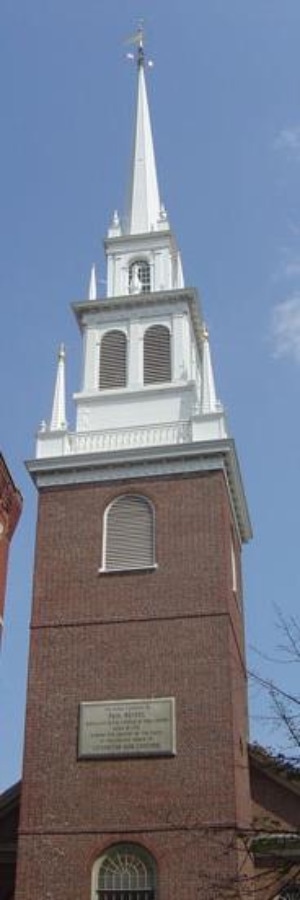On April 19, 1775, the British Army in Boston prepared to march troops into Middlesex County,Massachusetts to seize the muskets and gunpowder of the local militias. Because of the danger posed by large amounts of gunpowder, militiamen only had filled powderhorns at home. The rest was kept in local magazines.
Rebel spies noted the movement of the Lobsterbacks and hung lights in the steeple of the Old North Church to signal riders in Cambridge.
The riders fanned out across the countryside, alerting the militiamen.
In the predawn hours of April 19th, about eighty militamen, known to history as the Minutemen, assembled on the green in Lexington to meet the marching soldiers.
The orders given to the Minutemen were concise and clear.
Somebody did fire a shot; the Minutemen skirmished with the advanced guard of the British expedition. The soldiers marched onto Concord, searching homes and farms for weapons. The Minutemn fired across the North Bridge, wounding most of the British officers with their first volleys. The British were turned back.
When the British Army left Concord, the fighting turned brutal and nasty. Rumors flew through the British ranks that one of their dead in Concord had been scalped. In searching some of the houses, British soldiers found liquor and drank it, with some of the Redcoats becoming intoxicated. Many of the searches of homes were done with a heavy hand, outraging the inhabitants, most of whom still considered themselves to be Englishmen.
While it's likely that the legend of long-range rifle fire was a myth, Minutemen fought in both organized formations and as skirmishing dragoons-- riding up on horseback to cover, firing from cover and then fleeing. Minutemen shot at the Redcoats from longer ranges, even though smoothbore muskets of the era were capable of shooting a 72" group at 100 yards (M-1 rifles had a design accuracy of 4" groups).
Homeowners began to resist the British, including men as old as eighty years old. British officers struggled to control their soldiers, who were often liquored up, from killing civilians. The British commanders in Boston sent reinforcements to rescue the expedition and they made it back to Boston.
Boston in the 18th Century was a peninsula in name only. Tactically, Boston was an island connected to the mainland by a thin bridge of land.
Over ten thousand militiamen from eastern and southern New England soon arrived to lay siege to the town of Boston.
The Revolutionary War was underway, though it would be more than a year before that fact was fully acknowledged by the rest of the American colonies.
Update: I wrote this post a few days in advance. By coincidence, a friend and I spent an hour today (Patriots' Day) at a pistol range.
Not So Closed Minded, Part 49
24 minutes ago
















3 comments:
Actually the british used muskets with their typically 50 yd range with accuracy or worse,
being a shorter barrel and smooth bore. See Brown Bess.
The typical militiaman had a good hunting long barreled often rifled or fowling gun firing shot and was more experienced in firing for accuracy. The accurate Kentucky rifle, a longer barrel rifle with rifling and known for accuracy at extended ranges.
Further with earlier French and Indian wars the Colonials were skilled in long shots and irregular war tactics. Rather than stand in rows and take a beating they used hit and run with shots to take out those of apparent rank or in control. The other was Militiamen were
trained as individual elements that would harass and operate with independence rather than the monolithic columns working under strict single point control.
It is also believe that the British were at worse expecting a minor skirmish. Whet they encountered early on were small groups that
had trained and could shoot well.
It was a war that impacted war tactics not unlike the Civil war and then WW1.
Eck!
I'm familiar with the Old North Bridge, and that painting is fascinating. If it's accurate, then the timbers of the bridge have been replaced, but the design kept nearly identical. Actually, that's what I've read about the bridge.
If the bridge was rebuilt the same, the water's fairly high. Normal for April. On more than one occasion, I've seen both ends of the bridge under river water. That renders the land the Minutemen are standing on an island. A monument to them, very like the Lexington monument, stands in the path about 20 paces behind the right edge of the painting.
About at the base of that tree center left, or perhaps a few paces closer, is a monument to three British soldiers buried on that spot. The British side of the river is very wooded now. Very pretty place to walk. The farmer's field in the center is still a field, though.
Behind the rebels, there's farmer's fields. (I forget the name of the farmer, but I think he's one of the Minutemen, and his house was probably used. It's currently a stone foundation, and a museum stands nearby.) The land slopes up, and currently has a stone wall along a road that would make a fantastic place to make a stand. That's probably 200 yards from this point, though.
The river flows to the left, but slowly. Here's a reverse angle, high resolution image: http://freepages.genealogy.rootsweb.ancestry.com/~robert/OldNorthBridge.jpg
The Minuteman statue is obscured by foliage. The water is low. The photographer is standing right by where the 3 British solders are buried.
If some Americans made a stand where the painting suggests, they probably had a long run in the open when things went bad. I don't know the battle well enough to know how it went here, just that this is where the British turned back.
Post a Comment